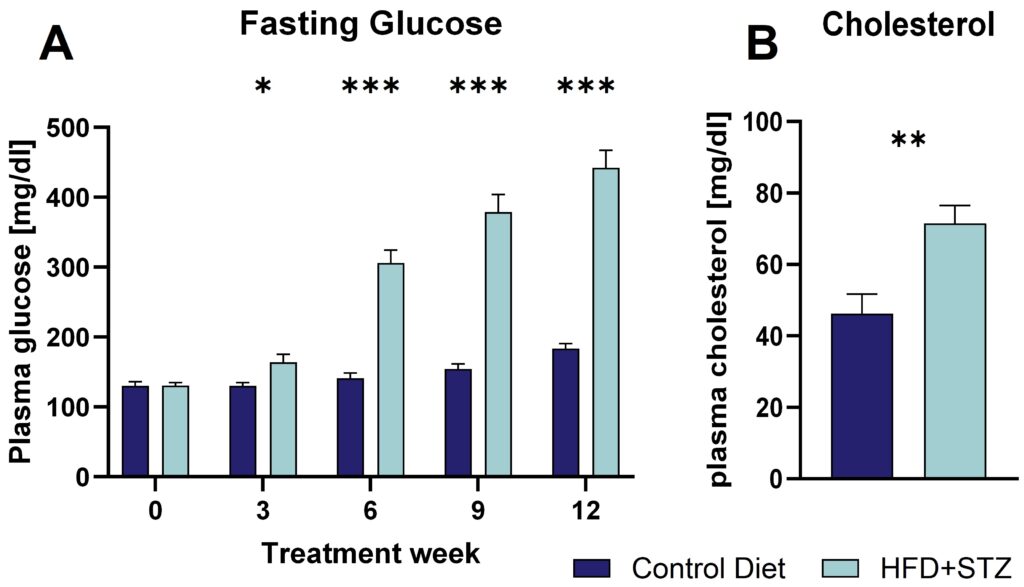Obesity is a chronic complex disease defined by excessive fat deposits that can impair health. It is classified as an epidemic and in 2022, 43% of adults were reportingly overweight and out of these, 30% were obese.
Obesity and the related metabolic syndrome are risk factors with incredible extensive reach, and are connected to type 2 diabetes (T2D), cardiovascular diseases, certain cancers, liver diseases, gastrointestinal disorders, mental health issues, and many more. In recent years, they became recognized as important risk factors for several neurodegenerative diseases, such as Alzheimer´s disease (AD), Parkinson´s disease (PD), multiple sclerosis (MS), amyotrophic lateral sclerosis (ALS), and more.
A high-fat diet, characterized by an excessive intake of dietary fats, is a well-established contributor to obesity. In animal studies, a high-fat diet is frequently used to induce obesity and study its effects on metabolism. Streptozotocin is a naturally occurring compound that is selectively toxic to β cells of the pancreatic islets and is commonly used for inducing T2D in animal models. T2D is characterized by abnormalities in insulin secretion and a decrease in functional efficiency of circulating insulin, resulting in an insulin resistance.

Figure 1: Weight gain over time in T2D-induced mice. Animals treated with high fat diet (HFD) and streptozotocin (STZ) started gaining weight from week 4 onwards, with a significant increase in body weight compared to control animals in week 8. Week 0 = Baseline. Mean + SEM; two-way ANOVA followed by Bonferroni’s post hoc test, n = 16-19 mixed sex animals per group and time point.
Scantox offers the obesity model, with or without comorbid diabetes in transgenic as well as non-transgenic animals. Animals exhibit increased weight gain (Figure 1) and food consumption, elevated glucose levels (Figure 2A) and cholesterol levels (Figure 2B). Depending on the model, also mild cognitive impairment can occur as well as liver dysfunction and other metabolic changes. Additionally, modelling T2D diabetes in APPSL x hQC transgenic animals increases levels of insoluble 38-, 40- and 42- amyloid-β (for more information see your publication Adekunle Babalola et al., 2024).

Figure 2: Changes in fasting glucose and cholesterol levels in animals with induced T2D. Changes in glycaemic parameters (A) are observed already in week 3 after T2D induction. Mean + SEM; two-way ANOVA followed by Bonferroni’s post hoc test; n = 16-19 mixed sex animals per group and time point. Changes in plasma cholesterol levels 14 weeks after T2D induction (B). Week 0 = Baseline. Mean + SEM; two-tailed t-test, n = 7-8 mixed sex animals per group. *p<0.05; **p<0.01; ***p<0.001. HFD: high fat diet, STZ: streptozotocin, T2D: type 2 diabetes.
Scantox offers custom tailored study design for the T2D model and we are flexible to accommodate to your special interests. We are also happy to advice you and propose study designs. Since the T2D model is an induced model, it grants an incredibly short turnaround time. Scantox maintains its own colonies of transgenic mouse models.
We would be happy to test your compounds in these mouse models! Readouts depend on the model but the most common are:
- Body weight
- Food consumption and caloric intake
- Learning and memory deficits
- Glycaemic parameters (fasting insulin and glucose, HOMA-IR, HOMA-β)
- Glucose tolerance and insulin sensitivity
- Whole gut transition time and impaired gastric emptying
- Adipose tissue collection and weight (e. g. mWAT, eWAT)
- Cholesterol (total, free and esterified), HDL, LDL and triglycerides levels
- Cholesterol metabolism associated gene expression (q RT-PCR)
- Aspartate aminotransferase (AST), alanine aminotransferase (ALT), and alkaline phosphatase (ALP) levels in plasma
- Inflammation markers
- BBB dysfunction/leakage
You might also interested in:
We are happy to receive your inquiry.


